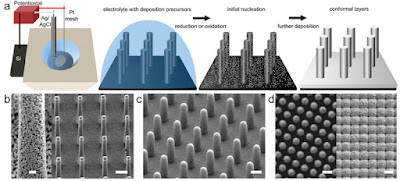Electrodeposition can be used to construct novel functional nanowire structures hitherto impossible. This is the new finding from researchers at Harvard University in the US who have deposited conformal layers of various materials onto high-aspect-ratio silicon and micro- and nanowire arrays of different diameters, pitch, aspect ratios, shapes, resistivity and orientation. The structures produced could find use in a wide range of technology applications in chemistry, physics and medicine as well as in energy conversion and storage, sensing and bioelectronics.
Being able to construct ever more complex nanostructures has allowed researchers to study many fundamental physics and chemistry phenomena, and to develop applications for use in a variety of different fields. For example, some 1D nanostructures can be used to manipulate light–matter interactions in novel sensing and light harvesting devices. Nanoelectronics devices based on 1D silicon nanowires can also be employed in bioelectronics and drug-delivery devices.
Further developing the architecture and compositions of such structures with metal-based and polymeric materials could lead to even more sophisticated applications. Electrodeposition could come into its own here since it has proved itself to be an efficient way to deposit films of different materials on flat materials. To date, however, it had never been used to modify nanowire structures with uniform shells or to prepare multiple coaxial shell layers.
Electrodeposition on silicon produces novel nanowire architectures, Belle DuméNanotechweb.org

Comments